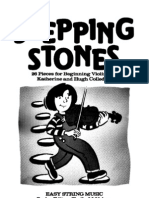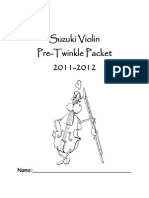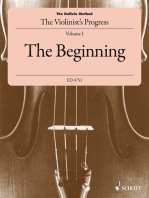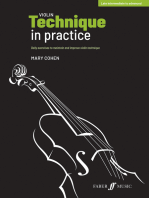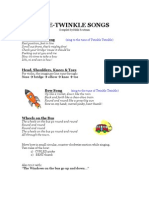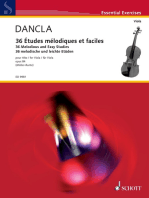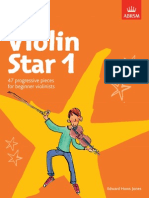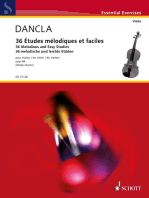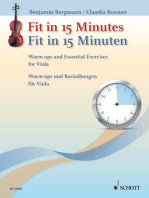Colour Strings
Colour Strings
Uploaded by
Clare CooneyCopyright:
Available Formats
Colour Strings
Colour Strings
Uploaded by
Clare CooneyOriginal Description:
Copyright
Available Formats
Share this document
Did you find this document useful?
Is this content inappropriate?
Copyright:
Available Formats
Colour Strings
Colour Strings
Uploaded by
Clare CooneyCopyright:
Available Formats
continues to inspire
The world-famous method is the outcome of a passion for teaching.
usic matters. It develops the child
all-embracingly. Children who make
music will learn almost everything
else more easily. But should they have to give
up childhood, the shortest yet most precious
and decisive stage in their personal development in order to enter the land of music? The
Colourstrings approach based on the Kodly
philosophy aims to solve this conflict by creating an environment in which singing, playing
games and instruments live side by side, for the
happiness of the child. A music land such as this,
which is an integral part of the childs world of
play, should be available to all.
HOW IT BEGAN
The Hungarian inventors of the method,
Gza and his brother
Csaba Szilvay, began
teaching in Finland in
1971. Their approach
was developed little by
little. After years in use,
various illustrations,
visual
explanations,
musical pieces, chamGza Szilvay
ber music arrangements and exercises in technique came to constitute a method and the Colourstrings School
was born. The first-generation Colourstrings children were raised at the East Helsinki Music Institute. They began by giving concerts at their own
music school, but gradually made appearances on
other concert podiums and eventually started to
draw attention to themselves. Then a series of
56 programmes (Mini-fiddlers in Musicland)
shown on Finnish television revolutionised music
education in Finland. Thousands of families were
introduced to music in their homes, and shops
all over Finland soon ran out of instruments. The
strings boom had begun.
The Helsinki Junior Strings were formed 30
years ago from the Colourstrings pupils at the
East Helsinki Music Institute. Still conducted by
Gza Szilvay, the orchestra has performed regularly abroad, made a number of records and more
than 70 TV appearances.
INSTRUMENTAL TUTORS
Seeing and hearing go hand in hand in
Colourstrings teaching. In the Violin ABC the
four strings are identified by different colours
and characters. Initially reading music means
matching colours and following the melodic line
of pictures. In this way reading is not a burden
to the child. The colourful pictures and notes
gradually give way to conventional notation.
At the beginning Colourstrings uses relative
solmisation (a movable Do) and the child is later
introduced step by step to the absolute letter
names and pitch.
The instrumental tutors are not limited to
teaching manual dexterity, since they also tend
to present the child with the music as a whole,
as a package in which instrumental technique,
musical listening, understanding and emotions
are at all times balanced.
Individual tuition is complemented by group
teaching which introduces the child to chamber
music at an early age. The instrumental tutors
are therefore accompanied by chamber music
series, such as the Violin Duos arranged by
Lszl Rossa.
Colourstrings is a child-oriented mode of
teaching music. The philosophy and method
do not form or mould the child to suit the
instrument; rather, they tame the instrument
and the teaching to meet the needs of the child.
The Colourstrings method has been used
by 40,000 string players around the world. In
Finland every second Colourstrings-trained
child has, on estimate, become a professional,
and quite a few have even won international
recognition. Musicians such as Pekka and Jaakko
Kuusisto, Rka Szilvay, Jan Sderblom, Linda
Lampenius and Marko Ylnen now on the
international circuit started with this method.
Looking back over 30 years, Gza Szilvay can
spot some salient features of children trained by
the method:
Fine intonation
Equally advanced technique in both hands
A developed musical intellect
Good ability to read music
An artistic aptitude for musical timbre,
nuance, detail and phrasing
Rich creativity developed through transposing, transforming, improvising and
composing
Solo playing developed alongside chamber
and orchestral musicianship (solo/soli/tutti).
Teachers who have attended Szilvays courses
often say that the method contributes to the
childs social education as well. Many children
from difficult backgrounds have, through music,
become more motivated and cheerful.
ESSENTIAL TEACHER TRAINING
Teacher training is an important part of the
method. Gza and Csaba Szilvay have lectured
at close to 130 congresses, courses and symposia around the world since 1977. Colourstrings
International was established in London in 1990
and soon grew to take in national and international teacher-training courses. Nowadays CI
arranges courses for kindergarten, violin, cello,
piano, guitar, viola and double-bass players and
teachers. The UK has a network of Colourstrings
kindergartens, and several thousand children are
being brought up through these musical playschools.
Colourstrings is gaining popularity throughout the English-speaking world. It has been
fostered by such international organisations as
ESTA (European String Teachers Association),
ASTA (American String Teachers Association),
AUSTA (Australian String Teachers Association), ISME (International Society for Music
Education), NMPU (Nordic Music Pedagogical
Union) and IKS (International Kodly Society).
The numbers of academies and conservatories
that teach it and of masters and doctoral theses
on it is growing steadily.
According to Gza Szilvay, the Colourstrings
method can make a violinist of almost anyone
with five fingers. The key to maintaining musical
culture nevertheless lies with the teachers. Given
a teacher such as Szilvay fired with a passionate
desire to train future generations, the classical
musical heritage has nothing to fear.
HENNA SALMELA
This article is based on interviews and texts by
Gza Szilvay.
You might also like
- Suzuki Violin 12-Week Lesson Plan KC-MMTCDocument15 pagesSuzuki Violin 12-Week Lesson Plan KC-MMTCKenneth Chia90% (21)
- Katherine & Hugh Colledge - Stepping StonesDocument8 pagesKatherine & Hugh Colledge - Stepping Stonessulpizio78% (9)
- Music Learning Theory for Newborn and Young ChildrenFrom EverandMusic Learning Theory for Newborn and Young ChildrenRating: 4 out of 5 stars4/5 (10)
- Haydn-Violin Concerto C Maj. Cadenza-ViolinSheets PDFDocument4 pagesHaydn-Violin Concerto C Maj. Cadenza-ViolinSheets PDFPaolo A. CatalanoNo ratings yet
- Most RasDocument73 pagesMost RasPaulo Azevedo100% (4)
- Suzuki Violin Pre-Twinkle Packet 2011-2012: NameDocument14 pagesSuzuki Violin Pre-Twinkle Packet 2011-2012: NameJessica Duas100% (10)
- Suzuki Pre-Twinkle Games: Ideas To Use ThemDocument7 pagesSuzuki Pre-Twinkle Games: Ideas To Use ThemKareliaTarazonaCruz100% (2)
- Asta Violin SyllabusDocument26 pagesAsta Violin SyllabusLee Wilkins100% (4)
- The Doflein Method: The Violinist's Progress. The BeginningFrom EverandThe Doflein Method: The Violinist's Progress. The BeginningRating: 5 out of 5 stars5/5 (4)
- 101 Rhythm Instrument Activities for Young ChildrenFrom Everand101 Rhythm Instrument Activities for Young ChildrenRating: 4 out of 5 stars4/5 (2)
- Shinichi Suzuki - His Speeches and Essays - Suzuki MethodDocument55 pagesShinichi Suzuki - His Speeches and Essays - Suzuki Methodapollinia54100% (3)
- 358 Pre-Twinkle Ebook 29pagesDocument29 pages358 Pre-Twinkle Ebook 29pagesSarahî Ledesma100% (6)
- Parker (2014) A SURVEY OF VIOLA TEACHERS' PERCEPTIONS OF VIOLA PEDAGOGYDocument187 pagesParker (2014) A SURVEY OF VIOLA TEACHERS' PERCEPTIONS OF VIOLA PEDAGOGYcaner100% (1)
- Pre Twinkle SongsDocument2 pagesPre Twinkle Songskraftee100% (3)
- Best Pieces To Play On The ViolinDocument6 pagesBest Pieces To Play On The ViolinCarlo100% (4)
- Viola Fundamentals Book: Table of Contents I. Left Hand ActionDocument33 pagesViola Fundamentals Book: Table of Contents I. Left Hand ActionAnnisa AnggraeniNo ratings yet
- Viola Levels 1a - 10Document6 pagesViola Levels 1a - 10api-291489883No ratings yet
- Copertina Galamian Vol 2Document1 pageCopertina Galamian Vol 2Rolando0% (1)
- Violin Curriculum - Eastman Community Music School - Eastman School of MusicDocument7 pagesViolin Curriculum - Eastman Community Music School - Eastman School of MusicBaran Aytac100% (1)
- SuzukiViolinRepertoire PDFDocument3 pagesSuzukiViolinRepertoire PDFAurora del RíoNo ratings yet
- Recommended Reading PDFDocument1 pageRecommended Reading PDFHermaphrobot100% (2)
- Korguev Double StopsDocument33 pagesKorguev Double StopsDavid GiardinoNo ratings yet
- Suzuki HandbookDocument20 pagesSuzuki Handbooksksanchez95% (19)
- Piano PiecesDocument3 pagesPiano PiecesClare Cooney100% (1)
- FLP10106 Get Moving With Ella JenkinsDocument3 pagesFLP10106 Get Moving With Ella JenkinstazzorroNo ratings yet
- Approaches in Early Childhood MusicDocument15 pagesApproaches in Early Childhood MusicAna Mejia100% (4)
- Colour Strings ArtDocument4 pagesColour Strings ArtPaula MidãoNo ratings yet
- Voima Noora PDFDocument35 pagesVoima Noora PDFDaryHeuvelmanNo ratings yet
- Taking the Orff Approach to Heart: Essays & Articles from a Pioneer of Orff in AmericaFrom EverandTaking the Orff Approach to Heart: Essays & Articles from a Pioneer of Orff in AmericaNo ratings yet
- Music Lessons: Guide Your Child to Play a Musical Instrument (and Enjoy It!)From EverandMusic Lessons: Guide Your Child to Play a Musical Instrument (and Enjoy It!)Rating: 4 out of 5 stars4/5 (8)
- Step Practice Plan PretwinklersDocument1 pageStep Practice Plan Pretwinklersapi-297642460No ratings yet
- A Qualitative Study of Geza SZDocument131 pagesA Qualitative Study of Geza SZAndrea Fernández BarrosNo ratings yet
- 10 Steps Violinist - Com PDFDocument12 pages10 Steps Violinist - Com PDFsubz100% (2)
- European Suzuki Association - Teacher Training (March 2013)Document54 pagesEuropean Suzuki Association - Teacher Training (March 2013)vilt100% (2)
- Literature of Violin PiecesDocument4 pagesLiterature of Violin Piecesتابلۆ اومید محمدNo ratings yet
- Violin DuosDocument1 pageViolin DuosSiva PrasadNo ratings yet
- Group Class IdeasDocument2 pagesGroup Class IdeasJacqueline Napora100% (1)
- Psycological Analysis of Violin Student Personality Traits 101Document24 pagesPsycological Analysis of Violin Student Personality Traits 101Angelo Z. Cabrera100% (1)
- Suzuki Program Parent Handbook (Revised 2013)Document27 pagesSuzuki Program Parent Handbook (Revised 2013)johaber100% (3)
- Violin Star Is SuuDocument5 pagesViolin Star Is SuuJuan Pablo Peñalva87% (15)
- Jazz Pizzcato ViolaDocument2 pagesJazz Pizzcato ViolaAdyatmaka JatiNo ratings yet
- Violin Pieces by LevelsDocument11 pagesViolin Pieces by LevelsScribdTranslationsNo ratings yet
- Sheila M.nelsonDocument4 pagesSheila M.nelsonPilar Véliz PedroNo ratings yet
- Viola Scales - Wollman, Rose (DM Viola)Document170 pagesViola Scales - Wollman, Rose (DM Viola)GuilhermeDeCarvalho100% (4)
- Tropical Rhythms - Updated Aug 23 2015Document64 pagesTropical Rhythms - Updated Aug 23 2015api-291489883No ratings yet
- 3 Duets From Robert Schumann's: Album For The YoungDocument7 pages3 Duets From Robert Schumann's: Album For The YoungGran Pierráh Coral & OrquestraNo ratings yet
- FromSingingtoPlayingteachingviolinfromaKodalyperspective 1Document24 pagesFromSingingtoPlayingteachingviolinfromaKodalyperspective 1walter100% (1)
- Pathways Through The Violin SyllabusDocument10 pagesPathways Through The Violin SyllabusOsmank100% (2)
- ABRSM Violin Grade 3 2020-23Document1 pageABRSM Violin Grade 3 2020-23echotanlsNo ratings yet
- Suzuki in Education PaperDocument11 pagesSuzuki in Education PaperKenneth Chia100% (1)
- Trinity - String ExamsDocument156 pagesTrinity - String ExamsArthur LoboNo ratings yet
- 4) Sassmannhaus AnalysisDocument2 pages4) Sassmannhaus AnalysisrohanfreakNo ratings yet
- A Comprehensive Viola Bow-Arm Method Based On Open Strings ExerciDocument123 pagesA Comprehensive Viola Bow-Arm Method Based On Open Strings Exercigmayoral6100% (1)
- SuzukiDocument9 pagesSuzukiapi-215421914No ratings yet
- Article Summary Suzuki Method and Edwin GordonDocument5 pagesArticle Summary Suzuki Method and Edwin GordonJohn Aloysius RobertNo ratings yet
- Guidelines Suzuki Early Childhood Education Teacher TrainingDocument8 pagesGuidelines Suzuki Early Childhood Education Teacher Trainingjornsh9511No ratings yet
- Violin La Clase Colectiva Vol 2 (Duos Violin Faciles-Easy Duets Violin)Document67 pagesViolin La Clase Colectiva Vol 2 (Duos Violin Faciles-Easy Duets Violin)Fran Palacios92% (12)
- Fit in 15 Minutes: Warm-ups and Essential Exercises for ViolaFrom EverandFit in 15 Minutes: Warm-ups and Essential Exercises for ViolaRating: 5 out of 5 stars5/5 (1)
- Symbols Sheet For MusicDocument1 pageSymbols Sheet For MusicClare CooneyNo ratings yet
- Strings Program 2019Document2 pagesStrings Program 2019Clare CooneyNo ratings yet
- Student PiecesDocument2 pagesStudent PiecesClare CooneyNo ratings yet
- Program Edvard Grieg Violin Sonata 3 Opus 45, C MinorDocument3 pagesProgram Edvard Grieg Violin Sonata 3 Opus 45, C MinorClare CooneyNo ratings yet
- Theory Progra NotesDocument1 pageTheory Progra NotesClare CooneyNo ratings yet
- The Miraculous MandarinDocument4 pagesThe Miraculous MandarinClare CooneyNo ratings yet
- Conductor Richard Gill Remains A Musical Evangelist: The AustralianDocument6 pagesConductor Richard Gill Remains A Musical Evangelist: The AustralianClare CooneyNo ratings yet
- Lecture NotesDocument2 pagesLecture NotesClare CooneyNo ratings yet
- Itinerary: Date Location DescriptionDocument2 pagesItinerary: Date Location DescriptionClare CooneyNo ratings yet
- My Life As A Musician 3 s2973416Document8 pagesMy Life As A Musician 3 s2973416Clare CooneyNo ratings yet
- Tony Wheeler - Movement For String Orchestra in Memoriam Dmitri ShostakovichDocument1 pageTony Wheeler - Movement For String Orchestra in Memoriam Dmitri ShostakovichClare CooneyNo ratings yet
- Romantic Lecture 19Document4 pagesRomantic Lecture 19Clare CooneyNo ratings yet
- Pedagogy FinalDocument11 pagesPedagogy FinalClare CooneyNo ratings yet
- Print Diploma ABRSMDocument1 pagePrint Diploma ABRSMClare CooneyNo ratings yet
- Pedagogy DraftDocument11 pagesPedagogy DraftClare CooneyNo ratings yet
- Chromatic Chords (Quick Reference)Document1 pageChromatic Chords (Quick Reference)Clare CooneyNo ratings yet
- The Dominance FactorDocument3 pagesThe Dominance FactorClare CooneyNo ratings yet
- Mapeh HWDocument3 pagesMapeh HWbeelzebubNo ratings yet
- ABRSM Jazz Aural TestsDocument3 pagesABRSM Jazz Aural Testspaolokboard100% (1)
- Stockfelt AdequateModesOfListening AudioCultureDocument4 pagesStockfelt AdequateModesOfListening AudioCultureAlexandre Trajano PequiniNo ratings yet
- The SwanDocument3 pagesThe SwanJoanna SmykNo ratings yet
- Choral MusicDocument16 pagesChoral MusicJonathan SpinksNo ratings yet
- Jack Dejohnette On Love Is Many-SplendoredDocument5 pagesJack Dejohnette On Love Is Many-SplendoredClint HopkinsNo ratings yet
- Heist Movies and British Culture Dominated The 60's Cinema Genre For Most If Not The Whole DecadeDocument7 pagesHeist Movies and British Culture Dominated The 60's Cinema Genre For Most If Not The Whole Decaderenz_adameNo ratings yet
- Stardust Resume DuoDocument5 pagesStardust Resume DuoMHD AMIN OMARNo ratings yet
- 31 - Bibliography PDFDocument6 pages31 - Bibliography PDFErduandNo ratings yet
- Neo Classicism g2Document16 pagesNeo Classicism g2Nestor AgostoNo ratings yet
- Yamaha PSR520 EDocument51 pagesYamaha PSR520 EGuilherme PeçanhaNo ratings yet
- Classical and Folk Dances in India - pdf-83 PDFDocument6 pagesClassical and Folk Dances in India - pdf-83 PDFMaheshNo ratings yet
- Holst ListeningDocument4 pagesHolst ListeningDebbiNo ratings yet
- Ben Davis Resume LHDocument2 pagesBen Davis Resume LHbjdonlineNo ratings yet
- Rob Cantor - Sheet Music - SHIA LABEOUF - LIVE - Full Score - ChoirDocument21 pagesRob Cantor - Sheet Music - SHIA LABEOUF - LIVE - Full Score - ChoirFake AccountNo ratings yet
- Artist Biography: Igor Stravinsky Was One of Music's Truly Epochal Innovators No Other Composer of TheDocument2 pagesArtist Biography: Igor Stravinsky Was One of Music's Truly Epochal Innovators No Other Composer of TheUy YuiNo ratings yet
- Jammu SirDocument14 pagesJammu SirbaluthemagicianNo ratings yet
- Paper3 GranadosDocument2 pagesPaper3 GranadoshannahngxemNo ratings yet
- Riccardo Belletti - Resume - Agosto 2022Document1 pageRiccardo Belletti - Resume - Agosto 2022Riccardo NiarNo ratings yet
- Contemporary Dance - PE3Document3 pagesContemporary Dance - PE3Hazel GeronimoNo ratings yet
- SECOND QUARTER EXAM - Attempt Review PEDocument16 pagesSECOND QUARTER EXAM - Attempt Review PEneiljohn geraldez100% (1)
- Music of Romantic Period - 3rd Quarter (MUSIC 9)Document30 pagesMusic of Romantic Period - 3rd Quarter (MUSIC 9)Neth ManaliliNo ratings yet
- Essence of Jazz Total ProgramDocument12 pagesEssence of Jazz Total ProgramMatt D FNo ratings yet
- Larry GrahamDocument2 pagesLarry GrahamSyarif WulffraatNo ratings yet
- It's Beginning To Look A Lot Like ChristmasDocument2 pagesIt's Beginning To Look A Lot Like ChristmasAna SousaNo ratings yet
- Theatre NotesDocument8 pagesTheatre Noteskayteelyn17No ratings yet
- KukuDocument4 pagesKukuOnanisław Spermacy WyfiutkiewiczNo ratings yet
- Eser Adı Bestecisi/Sanatçı Albüm/Film/Tür DüzenlemeDocument3 pagesEser Adı Bestecisi/Sanatçı Albüm/Film/Tür DüzenlemeMustafa Necati KarataşNo ratings yet
- Part 12 - Grade 6 Edumate Introduction To Music of AsiaDocument3 pagesPart 12 - Grade 6 Edumate Introduction To Music of AsiaAndrewOribianaNo ratings yet

